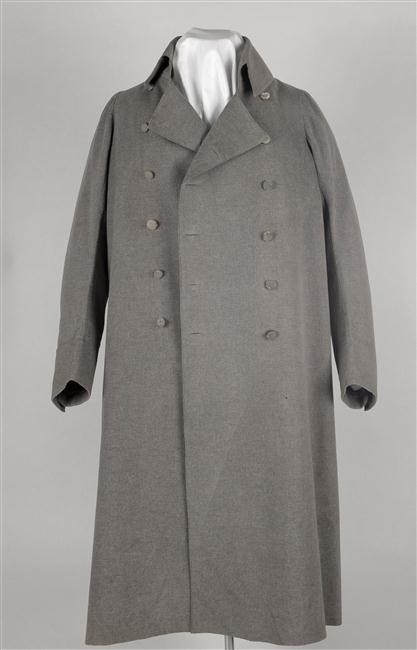The history of these greatcoats, also called “capotes”, is fairly well-known. They were first supplied by the tailor Chevallier, who was replaced in 1812 by his colleague Lejeune. Most of them were grey, but some could be blue or green. They were most often made of “drap de Louviers” (a high-quality textile) and lined with grey silk. A number of invoices are held at the French National Archives, concerning deliveries of these “redingotes” the first of which dates back to October 1804; initially invoiced at 200 francs, the price fell to 190 francs in 1808 and by 1813 Lejeune only charged them at 160 francs (by way of comparison, at the time, a day labourer earned between 1 franc and 1.50 francs per day!) From these various documents we know that each coat required two and a half “aunes” (unit of measure) of grey cloth, i.e. nearly 3 metres, three aunes of twill for the lining (about 3.50 metres), and cotton cloth for the pockets. The deliveries followed one another according to requirements: after the one delivered in October 1804, four others were delivered in August 1805 for Emperor’s visit to the Boulogne camp, then five more at the beginning of 1809, four in 1813, including a green one which cost 180 francs, two during the Hundred Days and one last one delivered in June 1815 just before leaving for Waterloo. When the “Grand Maître de la Garde-robe” (the Grand Master of the Imperial Wardrobe), Count de Rémusat, was replaced by Count de Turenne in 1811, the deliveries were regulated; it was decided that two redingotes, one grey and one coloured, would be delivered on 1 October each year so that the set would consist of six coats, without the colour being specified; each of which was to last three years. The Russian Campaign upset this fine organisation, three were burnt but Lejeune delivered a quite outstanding one at that time because it was padded and lined with chinchilla so that the Emperor could protect himself from the cold.
What remains of all these greatcoats? According to the inventory of furniture drawn up on St Helena on 5 May 1821 by the Emperor’s valet de chambre, Louis Marchand, only “two grey redingotes and one green one” remained. Drawn by lot after the Emperor’s death, one of the two grey greatcoats went to the Grand Maréchal du Palais, Henri-Gatien Bertrand, and then passed to his daughter-in-law, the Viscountess Bertrand, who died without descendants in 1885; it was through her that it came into the imperial family’s collections and was donated to the French State in 1979 by TT.II.HH. Prince Napoleon and his sister Princess Marie-Clotilde Countess de Witt (joining the collection of the Musée de Fontainebleau, N 263); in 1836 after the death of Madame Mère the second grey greatcoat was left to the Countess Camerata, daughter of Elisa, the former Grand Duchess of Tuscany; As it does not appear in the list of works she sold in 1854 to her cousin Napoleon III, we can suppose that, being considered a relic, she had given it to him and that it was the one the Emperor gave the same year to the Musée des Souverains where it was listed under number 220; it was transferred in 1891 to the Musée d’Artillerie, which is today the French Musée de l’Armée (Inv. Ca. 16). At the time of the distribution of the estate in 1836, the green greatcoat went to the former King Joseph and was given to the State in 1979 together with the grey greatcoat (Musée de Fontainebleau).
Bernard CHEVALLIER, May 2021 (translation RY)


